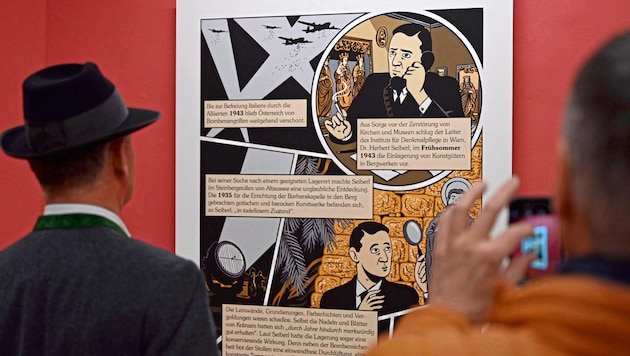New exhibitions
Ausseerland as an art depot for the Nazis
Two exhibitions at the Salzkammergut 2024 Capital of Culture in Ausseerland, Styria, will focus on the region's role as an art depot during the Nazi era. The Bad Aussee Chamber Museum is dedicated to the art collector and Nazi profiteer Wolfgang Gurlitt. And in the Altaussee Salt Worlds, "Hidden in the Rock", probably the most important storage site for Nazi-looted art, is the subject of the exhibition.
To put it in a nutshell: A considerable part of European cultural history in Ausseerland came safely through the Second War. On the one hand, thousands of paintings, sculptures and manuscripts were taken by the Nazis from 1943 onwards to the tunnel systems of the salt mine in Altaussee to be stored here in bomb-proof conditions and under the best possible conservation conditions. And on the other hand, some of the most important art dealers of the time settled in Ausseerland during the war years - along with their spectacular collections.
Looted art and distress sales
However, the fate of the artworks is in direct contradiction to the fate of their - often Jewish - owners. This is because a large proportion of the works mentioned here were looted art, so-called "degenerate art" or distress sales by Jewish collectors who used them to finance their escape.
The art dealer Wolfgang Gurlitt, to whom the Salzkammergut Capital of Culture 2024 is dedicating an exhibition at the Kammerhofmuseum in Bad Aussee, profited from the latter in particular. It is the second part of the exhibition trilogy "The Journey of Images", with which the Lentos Art Museum Linz is participating in the Capital of Culture Salzkammergut Bad Ischl 2024 - part one was recently opened in Linz.
"Gurlitt was one of the most important art dealers of his time and cultivated close contacts with Kokoschka and Kubin," explains curator Elisabeth Nowak-Thaller from Lentos, whose foundation in 1946 also goes back to an initiative by the politically well-connected Gurlitt and a purchase from his collection.
A visionary and profiteer
Although Gurlitt himself had a Jewish grandmother and his most important business partner was Jewish, he was able to come to terms with the Nazi regime to such an extent that he was able to continue his business from Bad Aussee, where he moved after the destruction of his Berlin gallery in 1943. "He did not stop at buying the collections of Jewish collectors who had to sell their artworks in order to flee far below the market price, nor did he take it too seriously after 1945 when it came to returning works that these collectors often left to him in trust for safekeeping," says Nowak-Thaller.
Gurlitt's life story is therefore almost emblematic of the ambivalent role that art and the art world played during the Nazi era. "He was a visionary on the one hand and a profiteer on the other," says Nowak-Thaller. In the exhibition at the Kammerhofmuseum, visitors can trace some of the stages of his life and his role in the art trade before, during and after the Second World War - including works on loan from the Lentos Museum Linz: artworks by Klimt, Schiele, Kokoschka, Kubin and Corinth.
6500 works in the salt mine
Gurlitt had also offered his services to the Nazis. They declined with thanks - and instead relied on Gurlitt's cousin Hildebrand, who played an important role in Hilter's collection for a later "Führer Museum" in Linz. Nevertheless, Gurlitt lived in Bad Aussee during the war, very close to a spectacular art depot, which is the subject of the "Hidden in the Rock" exhibition in Altaussee. Comic artist Simon Schwartz has not only explored the 7000-year history of salt mining in Altaussee, but also the years in which the Nazis stored their looted art in the tunnel system there.
Schwartz also tells the story of how some of the miners who worked there were able to prevent the Nazi Gauleitung from blowing up the mine at the end of the war, and with it the 6,500 or so paintings that were stored there. With this not entirely altruistic act - they were primarily concerned with preserving the mine as a workplace - they saved an art treasure long before the US Army's "Monuments Men" were able to begin their art rescue operation at the end of the war, which was also filmed by Hollywood.
Both exhibitions thus underline the central but also contradictory role played by the remote Ausseerland region in the art history of the 20th century. Both exhibitions are well worth seeing and can be viewed until November 3rd.













Kommentare
Da dieser Artikel älter als 18 Monate ist, ist zum jetzigen Zeitpunkt kein Kommentieren mehr möglich.
Wir laden Sie ein, bei einer aktuelleren themenrelevanten Story mitzudiskutieren: Themenübersicht.
Bei Fragen können Sie sich gern an das Community-Team per Mail an forum@krone.at wenden.